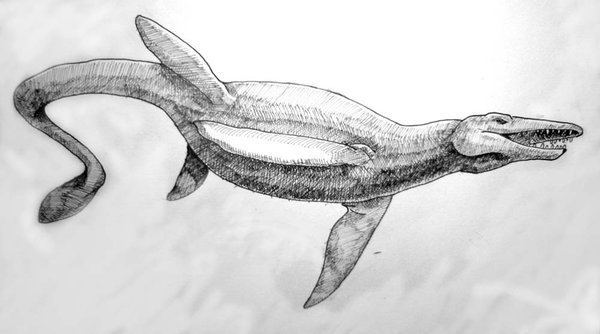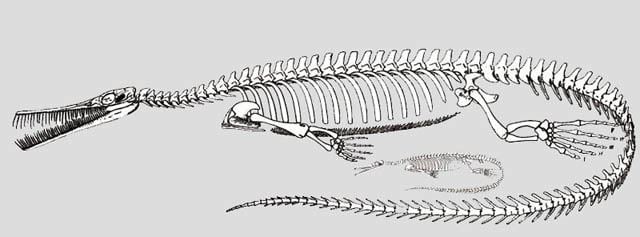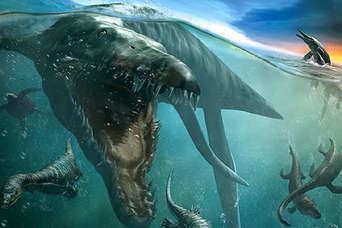Scientific name Mesosauridae Higher classification Mesosauria | Phylum Chordata Rank Family | |
 | ||
Order †MesosauriaSeeley, 1892 Similar | ||
Mesosaurs ("middle lizards") were a group of small aquatic reptiles that lived during the early Permian period, roughly 299 to 270 million years ago. Mesosaurs were the first known aquatic reptiles, having apparently returned to an aquatic lifestyle from more terrestrial ancestors. However, just how terrestrial mesosaur ancestors had become remains uncertain; recent research cannot establish with confidence if the first amniotes were fully terrestrial, or only amphibious. Most authors consider mesosaurs to have been aquatic, although at least some of them may have been amphibious, rather than completely aquatic, as indicated by their moderate skeletal adaptations to an aquatic lifestyle. They have long been thought to have been coastal forms that probably inhabited relatively shallow water, but recent research suggests that at least those from Uruguay inhabited a hypersaline environment, rather than a coastal marine environment. Recently described embryos show that pachyostosis of the ribs (which were thicker and denser than in terrestrial tetrapods) developed even before hatching, which suggests that mesosaurs were able to swim at birth, or shortly thereafter. They were apparently not very fast swimmers, with an optimal swimming speed estimated to have been between 0.15 and 0.86 m/s, but this must have been somewhat faster than the speed of their main prey, the pygocephalomorph crustaceans. Their reproductive mode is somewhat uncertain because association between adults and possible embryos in utero suggests viviparity, as in many aquatic reptiles, but a potentially isolated egg has also been found. Similarly, their affinities are uncertain; they may be either the most basal sauropsids, or among the most basal parareptiles.

Phylogeny

The phylogenetic position of mesosaurs has an important bearing on the definition of Reptilia. In one of the first major phylogenetic studies of amniotes (vertebrates laying eggs on land) Gauthier et al. (1988) placed Mesosauridae in a group called Parareptilia. Parareptilia means "at the side of reptiles" and was placed outside the clade Reptilia, which was considered a crown group. As a crown group, Reptilia included the most recent common ancestor of the two main lineages of living reptiles -diapsids and turtles- and all descendants of that common ancestor. In this sense, Reptilia was a node-based taxon because the first reptilian common ancestor would have been a "node" on the phylogenetic tree. Under this phylogeny, many extinct forms traditionally regarded as reptiles including mesosaurs were excluded from the group because they were outside the node.

The study of Laurin and Reisz (1995) was the second major phylogenetic analysis of amniotes. Like Gauthier et al., Laurin and Reisz used Reptilia as a crown group and placed mesosaurs outside the group. Their phylogeny differed in that the parareptiles of Gauthier et al. were now regarded as close relatives of turtles, within crown group Reptilia. Laurin and Reisz adopted the name Sauropsida as a node-based taxon including the last common ancestor of mesosaurs and Reptilia. Traditionally, amniotes are divided into two groups: a mammal lineage called Synapsida and a reptile lineage called either Reptilia or Sauropsida. In fact, the study of Gauthier (1994) defined Sauropsida as all amniotes more closely related to reptiles than to mammals, which meant that Sauropsida was a stem-based taxon encompassing the entire reptilian lineage or reptilian "stem" of Amniota (Synapsida was the mammalian stem). Under this phylogeny, the only group that prevents Sauropsida from being equivalent to Reptilia is mesosaurs.

More recent phylogenetic analyses, such as that of Modesto (1999), support that of Gauthier et al. (1988) by placing mesosaurs with parareptiles. However, these phylogenies follow Laurin and Reisz (1995) in placing Parareptilia within crown-group Reptilia, meaning that mesosaurs are once again members of Reptilia. Using Laurin and Reisz's node-based definition of Sauropsida as "The last common ancestor of mesosaurs, testudines and diapsids, and all its descendants", Sauropsida and Reptilia are equivalent groupings; mesosaurs and testudines are more closely related to each other than either group is to diapsids, meaning that the clade containing testudines and diapsids (which would be crown-group Reptilia) must also contain mesosaurs. Since Reptilia was named earlier than Sauropsida, it is used most often in modern phylogenetic analyses.

In 2012 it was revealed that Mesosaurus has holes at the back of the skull called lower temporal fenestrae, a characteristic once thought to be present only in synapsids and diapsids. The condition in the skull of Mesosaurus is most similar to that in synapsid skulls because both lack the upper temporal fenestrae of diapsids. Lower temporal fenestrae are so far known only in Mesosaurus, but may be present in all mesosaurs. The presence or absence of temporal fenestrae is an important consideration in the phylogeny of mesosaurs and other amniotes because the three major groups of amniotes -Synapsida, Diapsida, and Anapsida- have been named after the number of holes in their skull; Diapsida means "two arches" in reference to the two bars that close off the upper and lower fenestra, Synapsida means "fused arch" in reference to a single bar at the bottom of the skull closing a single fenestra, and Anapsida means "no arch" in reference to skulls that lack any bars or fenestrae. Mesosaurs were traditionally classified as anapsids because they were thought to have lacked temporal fenestrae. However, the occurrence of fenestrae in amniotes has been recognized a highly variable feature within the group for many years prior to their discovery in Mesosaurus; many anapsids such as Candelaria, Bolosaurus, and lanthanosuchoids possess lower temporal fenestrae. Furthermore, Anapsida is rarely considered a valid clade in recent phylogenetic analyses.

The phylogenetic position of mesosaurs influences the current understanding of how amniotes evolved temporal fenestrae. If the phylogeny produced by Laurin and Reisz (1995) is correct in that mesosaurs are basal sauropsids, the lower temporal fenestra may be a primitive feature in amniotes, present in amniote's most recent common ancestor. Synapsids would have retained their fenestrae, and so too would sauropsids except for turtles and most parareptiles. Another possibility under Laurin and Reisz's phylogeny is that lower temporal fenestrae evolved independently in mesosaurs, synapsids, diapsids, and some parareptiles, and that the lack of fenestrae is a primitive feature in amniotes. If instead mesosaurs are members of Parareptilia, the presence of temporal fenestrae is probably not a primitive feature in amniotes, and the lower temporal fenestrae in mesosaurs may be characteristic of a lineage of basal parareptiles that also includes fenestra-bearing lanthanosuchoids and Bolosaurus.
